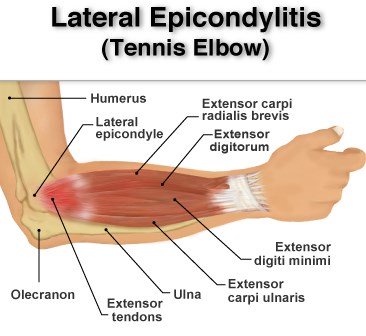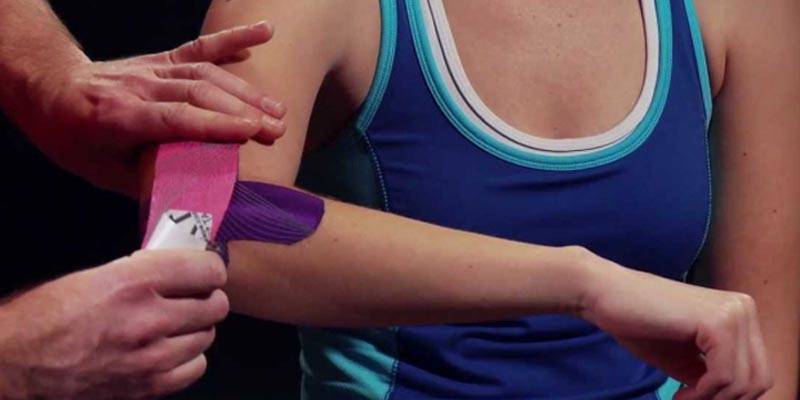nalco group
bone, muscle & joint pain physio
BOOK NOW / WHATSAPP ABOUT YOUR PAIN OR INJURY
- ORCHARD 400 Orchard Road #12-12 Singapore 238875
- TAMPINES 9 Tampines Grande #01-20 Singapore 528735
- SERANGOON 265 Serangoon Central Drive #04-269 Singapore 550265
Home > Blog > Physiotherapy & Hand Therapy > Elbow Pain > Tennis Elbow (Lateral Epicondylitis) Physiotherapy
Tennis Elbow (Lateral Epicondylitis) Physiotherapy

Funnily enough...people who get tennis elbow don't play tennis!
In fact, less than 5% of all cases of tennis elbow happen in people who play tennis - tennis elbow can happen to anyone who repeatedly uses their elbow, wrist, and hand for their job, sport, or hobby.
What Is Tennis Elbow (Lateral Epicondylitis)?
Tennis elbow is a painful condition caused by overuse of the "extensor" muscles in your arm and forearm, particularly where the tendons attach to rounded projections of bone (epicondyles) on the outside or lateral aspect of the elbow.
The muscles that you use to
- grip
- twist and
- carry objects
with your hand all attach to the "lateral epicondyle" at the elbow. That's why a movement of the wrist or hand can actually cause pain in the elbow.
Prolonged use of the wrist and hand, such as when using a computer or operating machinery —and, of course, playing tennis with an improper grip or technique—can lead to tennis elbow.
It can happen to athletes, non-athletes, children, and adults. Most of the time, it occurs more often in men than women, and most commonly affects people between the ages of 30 and 50.
Signs and Symptoms of tennis elbow

Symptoms of tennis elbow can happen suddenly as a result of excessive use of the wrist and hand for activities that require force, such as
- lifting
- twisting or
- pulling
Forceful activities—like pulling strongly on a lawn mower starter cord—can injure the extensor muscle fibers and lead to a sudden acute onset of tennis elbow.
Most of the time, though, symptoms of tennis elbow develop gradually over a period of weeks or months as a result of repeated or forceful use of the
- wrist
- hand and
- elbow
If you work as a grocery store cashier, you might have symptoms of tennis elbow as a result of repetitive (and often too forceful) typing—combined with continuous lifting of grocery bags.
Your symptoms may include:
- Pain that radiates into your forearm and wrist
- Difficulty doing common tasks, such as turning a doorknob or holding a coffee cup
- Difficulty with gripping activities
- Increased pain when you use your wrist and hand for lifting objects, opening a jar, or gripping something tightly, such as a knife and fork
- Elbow joint stiffness
- Weakness in the forearm, wrist, or hand
How Is It Diagnosed?
Tennis elbow usually occurs due to repeated movements.
As a result, other muscles and joints in this region of the body may be affected as well. Our senior physiotherapists and senior hand therapists will perform a careful examination not only of your elbow but of other areas of your body that might be affected and might be contributing to your pain.
We will perform special manual tests that help diagnose the problem and help detect conditions such as muscle weakness that might have led to the problem in the first place.
For instance, we might ask you to gently tense or stretch the sore muscles to identify the exact location of the problem.
X-ray are not required to diagnose tennis elbows, simply because x-rays won't reveal anything that is non-bony in nature (x-rays are mainly to view joint or bone abnormalities), and can't see anything "soft" like muscles, tendons, ligaments etc.
how our senior physiotherapists and senior hand therapists can help
The First 24 to 48 Hours
For the first 24 to 48 hours after acute onset of your pain, treatment includes:
- Resting the arm by avoiding certain activities and modifying the way you do others
- Using 10-20 minute cold therapy treatments
- Using elastic bandages or supports to take the pressure off of the painful muscles
We will assess and decide if you should use a brace or support to protect your muscles while the area is healing. Depending on severity, we may recommend that you consult with an orthopedic doctor for further testing or for consideration of additional treatment such as medication.
In rare cases, treatments such as cortisone injection or surgery might be needed. We can help you determine whether you need a referral to another health care provider as value-added service to you - we do have a medical network that we work closely with.
We can design a specific treatment program to speed your recovery.
There will very likely be exercises and other treatments that you will be expected to do at home. We also might use special physical therapy treatments to help relieve pain, such as
- manual therapy
- special exercises
- cold therapy
- heat therapy
- ultrasound therapy
- radio-frequency Indiba physiotherapy
- deep tissue release
For an "acute" case of tennis elbow—one that has occurred within the past few weeks— it's important to treat as early as possible. Left untreated, tennis elbow may become chronic and last for months and sometimes even years.
This is especially true if treatment is focused only on relieving pain and not on correcting the muscle weakness and bad habits that might have led to your condition in the first place.
Improve Your Ability to Move
We may use manual therapy to enable your joints and muscles to move more freely with less pain.
Insufficient muscle strength can lead to tennis elbow.
Sometimes the weakness is in the muscles of the wrist and forearm. In many cases, the problem stems from weakness of the supporting postural, or "core," muscles. In fact, you might find that it is necessary to improve your overall level of fitness to help manage your elbow condition.
Based on the evaluation, we can determine the type and amount of exercises that are right for you.
Our senior physiotherapists and hand therapists prescribe several types of exercises during recovery from tennis elbow:
- Early in the treatment, when the pain is most intense, we may recommend passive exercises in which your wrist and elbow are moved without the use of your muscles.
- As your symptoms improve, you can move the wrist and elbow actively without assistance.
- As the muscles become stronger and the symptoms have lessened, you
will be able to begin using weights or resistance bands to further
increase your strength. The amount of weight will need to be carefully
monitored to make sure you continue to progress and avoid re-injuring
your muscles.
Use Your Muscles the Right Way
We can help you retrain your muscles so that you use them properly. For example, when you lift a heavy grocery bag, you should contract the muscles around your shoulder blade and trunk to provide support for your arm muscles.
This simple movement can be easily taught to you by our senior physiotherapists and hand therapists can lessen the stress to the injured muscles and help you return to your normal activities while avoiding re-injury.
Return to Your Activities
We will help you remain active by teaching you how to modify your daily activities to avoid pain and further injury. Sometimes it's necessary to make changes at work, on the playing field, or in the home.
We can help you make simple modifications to your work site, your computer set-up, your kitchen devices, your sports equipment, and even your gardening tools to lessen the strain to your hand, wrist, and forearm. We will emphasize the importance of taking stretch breaks so that your muscles get frequent rest from repetitive movements and standing or sitting in the same position.
Yes, tennis may be a contributing factor to tennis elbow for several reasons. Sometimes the problem results from over-training. In other cases, the weight of the racquet or its grip may need to be adjusted. For others, the problem may stem from improper form, poor overall fitness, or a lack of strength in the supporting or "core" muscles of the trunk and shoulder blades.
We can help analyze the source of the problem and help find a solution.
